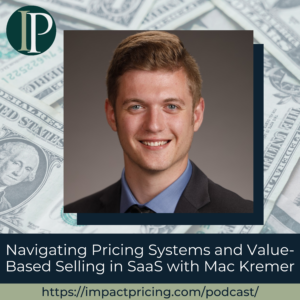
Join us in this episode as we get to preview some of the golden nuggets in Mark’s newest book.
Podcast: Play in new window | Download
Why you have to check out today’s podcast:
- Find out the important revenue buckets you must manage in subscriptions, so you maximize revenue
- Find out the three essential value levers that companies who are running subscriptions should have to manage and think about to arrive at a good pricing decision
- Discover four ways to grow your customers, so you increase revenue
“One of many things I find fascinating about subscriptions is that many subscription companies have figured out I have to go win customers, and I have to go keep customers. But far too few have figured out, hey, I really should spend time growing customers. And the real reason for that is it’s not urgent.”
– Mark Stiving
Topics Covered:
01:05 – Why Mark wrote the book ‘Win Keep Grow’
02:13 – The three key parts he considered when he wrote the book
03:05 – What he would do if he would rewrite the book and why
04:10 – How traditional businesses differ from subscription type ones
04:42 – Important three value levers that he built into the book
08:56 – Four ways to grow a customer
11:09 – Something fascinating about subscriptions
12:11 – Mark’s recommendation to companies
Key Takeaways:
“What I found fascinating about these three value levers is they seemed obvious to me as I’m working on subscriptions. And then you step back and say, Well wait, all three of those value levers are crucial for every business, we just don’t stop and think about them that way.” – Mark Stiving
“If we can target a really clear market segment, and we can build a product around that market segment, we can create the right packaging for it; we could have the right pricing metrics for it, then that market segment might have a higher willingness to pay. We’ll be able to keep them longer, and we’ll be able to grow more revenue from them. So, it just makes a ton of sense for us to be focusing a lot on market segments in our subscription world. But we should be doing that in our traditional business as well.” – Mark Stiving
“The fact that we’re constantly in contact with and helping and delivering value to our current customers gives us the ability to package our products in a way that we can continue to grow our revenue.” – Mark Stiving
“If we charge for the right things, and our customers use more of our product because we’re charging for the usage of our product, they end up paying us more. But what’s really important about that is, as our customers use more of our product, they’re getting more value. It’s okay that they pay us more. It isn’t like we’re trying to gouge them; we’re simply saying to them, hey, as you get more value, you pay us more money. And that seems really reasonable.” – Mark Stiving
Connect with Mark Stiving:
- LinkedIn: https://www.linkedin.com/in/stiving/
- Email: [email protected]
Full Interview Transcript
(Note: This transcript was created with an AI transcription service. Please forgive any transcription or grammatical errors. We probably sounded better in real life.)
Mark Stiving
One of many things I find fascinating about subscriptions is that many subscription companies have figured out I have to go win customers, and I have to go keep customers. But far too few have figured out, hey, I really should spend time growing customers. And the real reason for that is it’s not urgent.
[Intro]
Welcome to Impact Pricing, the podcast where we discuss pricing, value, and the documented relationship between them. I’m Mark Stiving, and today, we’re not going to have a guest. Instead, I’d like to give you some highlights from my new book, ‘Win Keep Grow: How to Price and Package to Accelerate Your Subscription Business.’ In fact, I’m not going to interview myself, but I’m going to answer the types of questions that I wish interviewers would ask me. Now I am often asked the question, why did I write the book? And that’s a great question. I was teaching for Pragmatic, and I’ve taught pricing for them for a very long time. And I sold them a pricing course; that’s where they got their pricing course from.
When I left the company, I didn’t want to compete with them. Instead of just teaching basic pricing then, I said, I’m going to go figure something else out. And I fell in love with this concept of subscriptions. I remember teaching pricing classes, and people would ask me, well, does this apply to subscriptions? And I would always answer, yeah, it’s the same thing because it’s customers perceiving value. The problem is, I didn’t understand the true nuances of what subscriptions really meant. After I left Pragmatic, I dove into this topic, and I studied and studied, and I had aha moment after aha moment. I really wanted to share these thoughts. And by the way, when I write a book, it also helps me organize all these thoughts in some structure, some way that makes sense. So that’s really why I wrote it, because I had a ton of Aha’s, and I wanted to share those Aha’s with you.
Now, when I wrote the book, I wrote it into three key parts, those three parts, starting out with the fundamentals of managing subscriptions. And that beginning is really just describing subscriptions. And a lot of the Aha’s I had, how are subscriptions different than running a more traditional business? The second section I called subscription lifecycle. And that’s really, as you’re managing a subscription product, the things you do are going to change from the time that you first introduce until you’ve got this very mature product at the other end. And I’ll talk a little bit more about that in just a few seconds. And then, the last section I created was transitioning to subscriptions. A lot of people are sitting around wondering, how do I get my company to move to a subscription? And this is hard; there’s no doubt about it. And so, I shared a bunch of learnings and thoughts that I had on that whole transition piece.
Now, it turns out, if I could write the book again, if I could start over today and rewrite it, I would rewrite it. And instead of writing it in those three parts, I think the parts I would use are the three fundamental techniques or foundational concepts that I teach throughout that book. And so those three frameworks that I’m going to use or that I talk about, first one is the title of the book, it’s Win Keep Grow — win, keep, grow are essentially the three revenue buckets that all subscription companies have to manage. You’ve probably heard the phrases acquisition revenue, retention revenue, and expansion revenue. And those are great phrases. They just sounded too much like consultantease to me. So, I renamed them into win, keep, and grow. We have to win customers; we have to keep customers, we have to grow customers. That seems pretty logical to me. And what I found that’s really unique is that we as subscription companies have to focus on each one of those three revenue buckets separately.
In a more traditional business, we never did that. In fact, most traditional businesses focus almost exclusively on how do I win new customers. We don’t worry about keeping them because we’re not getting recurring revenue. And we rarely worry about growing them, although many should be thinking about reselling or cross-selling. But most traditional companies think much more about how do I win new customers? In the subscription space, we all of a sudden are focusing on keeping customers and growing customers.
The second framework that I built into the book are three value levers. These three value levers are really important decisions, and topics that companies running subscriptions have to manage, have to think about. The first of those three value levers is market segment. What market segment are you targeting? The second one is packaging. How do you take all of your features and package them up into offers or different options that you might give your customers, your buyers? And the third one is the pricing metric. And the pricing metric is simply what do we charge for? What I found fascinating about these three value levers is, they seemed obvious to me as I’m working on subscriptions. And then you step back and say, well wait, all three of those value levers are crucial for every business; we just don’t stop and think about them that way. So yes, if we can target a really clear market segment, and we can build a product around that market segment, we can create the right packaging for it, we could have the right pricing metrics for it, then that market segment might have a higher willingness to pay, we’ll be able to keep them longer, we’ll be able to grow more revenue from them. So, it just makes a ton of sense for us to be focusing a lot on market segments in our subscription world. But we should be doing that in our traditional business as well.
The second value lever is the packaging. Typically, when I think of packaging, I think of good-better-best-plus options. And many times, when you look at companies, websites who are offering subscriptions, they offer good-better-best-plus options. What’s fascinating is in traditional businesses, we always have to worry about how we package our features up in the products. But because we usually only had one bite at the apple, one opportunity to sell to a customer, good-better-best was really there because we wanted people to buy our better product. In the world of subscriptions, we have lots of bites at the apple because our buyers, our customers, renew month after month or year after year, we still do good-better-best. But now we do it for a different reason. We build a good product, because that’s what we want to use to get people into our product line. We want them to use it and try it. And then over time, we could get them to upgrade from good to better or maybe better to best; maybe they could buy an option. The fact that we’re constantly in contact with and helping and delivering value to our current customers gives us the ability to package our products in a way that we can continue to grow our revenue.
The third value lever is the pricing metric. And this is probably the one I found most fascinating because, in traditional businesses, we sell things, right? We sell cars; we sell hamburgers. Remember, in software, we used to sell a shrink-wrapped box of Excel on the store shelf at the electronics store. But now we don’t sell things anymore. Now we sell access; we sell, you can use our product. And we find different ways to charge for our product. This is the pricing metric. What do we charge for? Probably the most common by far is, we charge by the number of users that a company has. But we might charge by the number of clicks or the number of gigabytes or the number of downloads or the hours viewed. There are lots of things we could choose to charge for once we get it, especially in the SaaS space world of subscription type businesses. And what I found fascinating about this is, once you start thinking about what do we charge for? Maybe even in a traditional business, you can go back and revisit that question. Because there are companies, there’s a coffee shop in Europe who charges by the hour instead of for the cup of coffee. That’s pretty fascinating. There’s a bookstore, a used bookstore in India, that charges by the pound of the books or the kilograms of the books, not by the price of each individual book. We might choose to rethink what do we charge for? When we rethink what we charge for, we have the potential to change markets to change industries.
The last of the three frameworks that I put in this book is there are four ways to grow a customer. When you think about growing a customer, we need to get for any given customer, how do I get more revenue from them next year than I got this year, the four ways we can grow customers or we could increase prices. Now obviously, if we increase prices, that’s going to be more effective if we’ve clearly targeted a market segment, we’ve built a product or a package that absolutely applies and delivers tons and tons of value. The customers use the product they perceive lots of value, they built it into their workflow, their lifecycle, lifestyle. Then when we raise prices, it’s really hard for somebody to leave us. Intuit, QuickBooks raises my prices every single year. And yes, I’m upset by it, but I still pay for it. I don’t have a choice. It’s part of my workflow, and the price it would cost me to switch out of that is huge. The second way we can grow a customer is through usage. We just got done talking about pricing metrics; what is it that we charge for? Well, if we charge for the right things, and our customers use more of our product because we’re charging for the usage of our product, they end up paying us more. But what’s really important about that is, as our customers use more of our product, they’re getting more value.
It’s okay that they pay us more. It isn’t like we’re trying to gouge them; we’re simply saying to them, hey, as you get more value, you pay us more money. And that seems really reasonable. The last two ways you can grow a customer, upsell and cross-sell. Upsell is if you’ve built good-better-best packaging, plus options, maybe we could get a buyer or a customer to move from the good to the better. And when they do that, they end up paying us more. That’s a way to grow a customer. Cross-sell is very similar, where they bought one of our products, they’re using it, and maybe we have other products that we could offer to them that are in the same market segment, but not directly related to the product that we’ve built already.
The thing I find fascinating, one of many things I find fascinating about subscriptions is that many subscription companies have figured out I have to go win customers, and I have to go keep customers. But far too few have figured out, hey, I really should spend time growing customers. And the real reason for that is it’s not urgent. Winning customers is really urgent because if you don’t win customers, you can’t have a business. Keeping customers is really urgent because if you don’t keep your customers, you start to lose revenue or your revenue decreases. But growing customers doesn’t feel urgent, because it doesn’t cause this big problem if you don’t do it. As long as I’m winning customers and keeping customers, I’m making revenue; I’m growing revenue. But those companies who learn to grow customers, they grow their revenue much, much more rapidly than customers who choose not to grow revenue. And the real issue is it’s not urgent.
My recommendation, typically to companies is, you’ve got to find a way to make this urgent; you’ve got to create metrics around it. Net dollar retention is a great metric that’s in the book. But you need to create metrics around this and hold people accountable, making it urgent inside your company. And then the company can grow amazingly fast.
Hope you don’t mind the fact that I talked about my book and what was in it a little bit. Hopefully, you’ll go pick it up. It’s available on Amazon now in three different formats. You can buy the paperback version, you can buy the Audible version, and you can buy the Kindle version. And it’s available in all bookstores as well, or most bookstores as well. And Episode Number 143 is all done. Thank you so much for listening. If you enjoyed this, would you please leave us a rating and a review? And finally, if you have any questions or comments about this podcast or pricing in general, feel free to email me at [email protected]. Now, go make an impact!
















